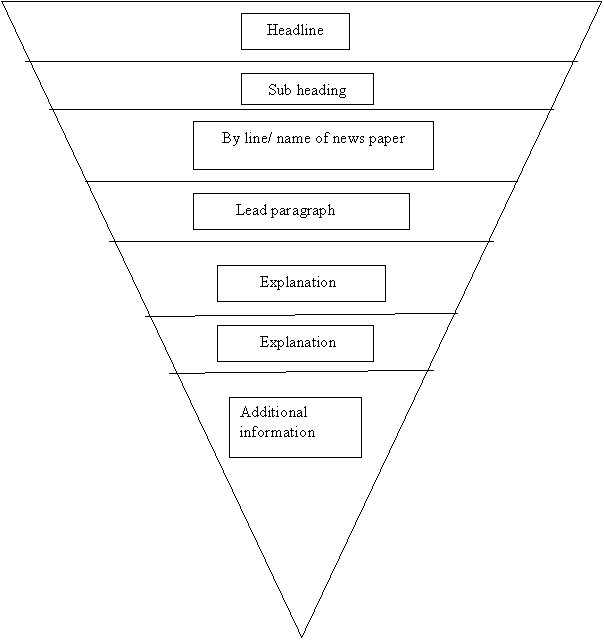

Byline : The name of the writer of the news report, usually appearing below the Headline. For example, you might see below the Headline or Subheading "Natalie Boss, Staff Writer" OR just "Natalie Boss". This would indicate that Natalie Boss was the reporter of the News Report.
Headline : Display type placed over a story summarizing the story for the reader. For example, this is easily identified as the font size is much larger than the text of the news report.
Lead or Lead Paragraph : The opening paragraphs of a news story containing the answers to who, what, where, when, why and how.
News report : A report of a current happening or happenings or current events in a newspaper by a journalist or reporter. For example, a news report could be about an earthquake or a shooting.
News article : An article reporting news.
Journalist : A person who practices journalism, the gathering and dissemination of information about current events, trends, issues and people.
Reporter or Newsperson : A person who investigates and reports or edits news stories. A reporter is a type of journalist who researches and presents information in certain types of mass media.
Newspaper headline : The heading or caption of a newspaper article.
Newspaper : A daily or weekly publication on folded sheets; contains news and articles and advertisements.
News Item : An item in a newspaper.
Forms of informational texts : Examples include: history book, geography text, report, and essay
Writing a news report is an example of an informational text. Newspaper articles require a different style of writing from what is used when writing a story. If you compare this text form to the graphic texts in Unit 1, or the narrative texts in Unit 2, you will see the difference. Not only are they different in form or structure, but also in the style of writing.
Newspaper reporters are careful not to show their personal feelings, but instead, report as accurately as possible the facts of an event. But, even though writing for the newspaper is factual, it should not sound boring. The article should still be interesting to the reader. Otherwise, no one will read the article.
In this unit, we will look at the structure of the news report. We will divide the structure into "tiers". In this lesson, you will be introduced to the news report and the form or structure. You will see "the big picture" in terms of the "look" and structure of the entire news report,
In the next lesson, we will focus on headlines, placement of the name of the newspaper and the news reporter. The next three lessons will focus on the three "tiers" of the body of the news report. Then, it will be your turn to write a news report.
Here are some important tips to consider:
Before reading the news report, let us look at a news report in the Globe and Mail. I will use numbers to label the basic parts of a news report.
Here is an explanation of the parts of the news report:
Number |
Parts of the news report |
1 |
Headline |
2 |
Sub Heading |
3 |
By Line |
4 |
Name of the news paper |
5 |
Lead Paragraph |
6 |
Explanation (could be two or more paragraphs) |
7 |
Explanation |
8 |
Additional Information |
The "Inverted Pyramid" is another way of representing the structure of the news report, and identifies the parts as follows:

As with any text – narrative, graphical or informational – the same before reading strategies apply. You were introduced to these in Unit 2. Even though the "form" is different, look at the text for the hints that will help in your understanding of the text.
Before reading a text, here are some helpful hints:
Look at the text and note the following:
Similarly, you need to ask yourself the same questions that guided you to a better comprehension of the narrative and graphical texts in Units 1 and 2.
The next step is to ask yourself these questions BEFORE reading:
Pre-Reading: Skimming and Scanning:
Likewise, as we read the news report, it is important to apply the skimming and scanning skills you acquired in Units 1, 2 and 3.
| If you have any questions, please ask your teacher before proceeding to the practice activity. |
Using the exemplar above, let us apply pre-reading strategies to the news report. When you do your assignment, refer to this exemplar as a model.
Areas |
Globe and Mail |
Was there a Headline? |
Yes |
Was there a Sub heading? |
Yes |
Was there a By line? |
Yes |
Was a newspaper acknowledged? |
Yes |
Was there a lead paragraph? How many sentences made up the lead paragraph? |
Yes. 3 sentences |
How many more paragraphs were there in the news report? |
3 more paragraphs |
What parts were bolded or had larger fonts? |
The headline and the sub heading |
Were there italics in the news report? |
Yes. |
What punctuation marks other than the period or the comma stood out in the news report? |
Brackets, dashes, question marks, quotation marks |
Were there pictures with captions in the news report? |
No |
Were there charts or diagrams or any other graphical features in the news report? |
No |
You will create a folder and keep all your reflective journal entries. You will need these for the final evaluation as you will have to reflect on your reading, writing and oral skills at the end of the course.
In your journal, reflect on the pre-reading strategies used in this activity. How can these strategies help you to better understand a text in any subject in school? Were the applications of these strategies similar to narrative and graphical texts?
Do you feel more confident as a reader with new material such as a news report?
Review the example from the Globe and Mail before starting the assignment.
This is a disclaimer. Not responsible for external links.